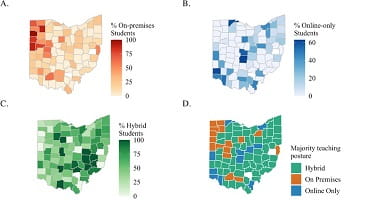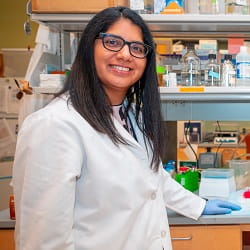
7/22/2021
 PITTSBURGH
PITTSBURGH – Ohio counties where the majority of kindergarten through 12th grade school students participated in fully remote learning during the 2020 fall semester had slower progression of COVID-19 and fewer deaths than schools with predominantly in-person learning, according to a new analysis by
University of Pittsburgh and
Carnegie Mellon University (CMU) scientists.
Although these findings were based on data before the introduction of vaccines, they still provide insight into precautions schools can take to lessen the spread of disease in the coming fall semester, as well as the value of quickly switching to remote learning should there be signs of a COVID-19 resurgence.
To provide information that could guide grade school planning for the 2021-2022 school year and avoid another rise in hospitalizations and deaths, the scientists published their findings in
medRxiv, a preprint website, and announced their results today, ahead of peer-reviewed publication.

“The data showed a dramatic increase in COVID-19 deaths in counties where most school children were learning in school in the fall of 2020, compared to counties where most children were learning online,” said senior author Seema Lakdawala, Ph.D., assistant professor in the
Pitt School of Medicine’s Department of Microbiology & Molecular Genetics. “Upon closer examination, counties that maintained mostly in-person learning were never able to get the spread of the virus under control during the school year.
“So, we need to be careful when we reopen schools to in-person learning in the fall—which we can do,” she said. “But we have to do it safely.”
The state allowed each school district to implement the teaching model that worked best for them. Ultimately, 16 counties had primarily in-person schooling, 11 had online-only classes and 59 implemented a hybrid model where students learned in school some days and at home on others. Two counties did not provide data.
Because Ohio adopted
statewide public health mandates, including masking, distancing and business closures, and the state has a fairly consistent geography and climate throughout, it was possible to compare outcomes in different counties. Still, the team had to deal with many confounding factors that could differ from county to county, such as mobility of residents, population density, population age and access to health care, among others.
Four CMU graduate students—Cheyenne Ehman, Yixuan Luo, Zi Yang and Ziyan Zhu—developed a computational model that returned a “growth factor” that describes whether COVID-19 in a given county was improving or worsening. Analysis was restricted to counties with similar population density, rural/urban status and mobility to account for many possible confounding factors.
Within three weeks of school starting, counties with in-person learning had worsening COVID-19 disease, compared to online and hybrid districts.

“We examined the acceleration of COVID-19 in a subset of comparable counties and right at the beginning of the semester when, presumably, the only change in the environment was school starting,” said Valérie Ventura, Ph.D., professor in the Department of Statistics and Data Science in
Dietrich College, as well as affiliated faculty in the
Machine Learning Department and at the
Center for the Neural Basis of Cognition at CMU. “The differences in disease growth observed could only be attributed to school posture with reasonable confidence.”
Vaccines and clinical treatments, coupled with more understanding of how SARS-CoV-2—the virus that causes COVID-19—spreads, better position the U.S. for safe in-person schooling this fall, but certain precautions should still be observed, said Lakdawala, who also is a member of
Pitt’s Center for Vaccine Research.
“Everyone who is eligible for a COVID-19 vaccine should be strongly encouraged to get one; masks should absolutely still be required, and schools should strive for the best possible ventilation and air purification,” she said. “And when a county appears to be experiencing an upswing in COVID-19 cases, moving to hybrid or online learning could help reduce spread and prevent deaths.”
Additional authors on this research are Sara Donovan, M.P.H., and James Lawler, M.D., M.P.H., both of the
University of Nebraska Medical Center; Annika Avery, of Pitt; and Jiayi Wang and Rebecca Nugent, Ph.D., of CMU.
MULTIMEDIA INFO: (click images for high-res versions)
Top:
CREDIT: Pitt, CMU
CAPTION: Pitt and CMU scientists investigated the link between COVID-19 deaths and disease spread with school learning models in fall 2020.
Middle:
CREDIT: UPMC
CAPTION: Seema Lakdawala, Ph.D., assistant professor, Department of Microbiology & Molecular Genetics, University of Pittsburgh School of Medicine, and member of Pitt’s Center for Vaccine Research.
Bottom:
CREDIT: CMU
CAPTION: Valérie Ventura, Ph.D., professor in the Department of Statistics and Data Science in Dietrich College, as well as affiliated faculty in the Machine Learning Department and at the Center for the Neural Basis of Cognition at CMU.

 PITTSBURGH – Ohio counties where the majority of kindergarten through 12th grade school students participated in fully remote learning during the 2020 fall semester had slower progression of COVID-19 and fewer deaths than schools with predominantly in-person learning, according to a new analysis by University of Pittsburgh and Carnegie Mellon University (CMU) scientists.
PITTSBURGH – Ohio counties where the majority of kindergarten through 12th grade school students participated in fully remote learning during the 2020 fall semester had slower progression of COVID-19 and fewer deaths than schools with predominantly in-person learning, according to a new analysis by University of Pittsburgh and Carnegie Mellon University (CMU) scientists.  “The data showed a dramatic increase in COVID-19 deaths in counties where most school children were learning in school in the fall of 2020, compared to counties where most children were learning online,” said senior author Seema Lakdawala, Ph.D., assistant professor in the Pitt School of Medicine’s Department of Microbiology & Molecular Genetics. “Upon closer examination, counties that maintained mostly in-person learning were never able to get the spread of the virus under control during the school year.
“The data showed a dramatic increase in COVID-19 deaths in counties where most school children were learning in school in the fall of 2020, compared to counties where most children were learning online,” said senior author Seema Lakdawala, Ph.D., assistant professor in the Pitt School of Medicine’s Department of Microbiology & Molecular Genetics. “Upon closer examination, counties that maintained mostly in-person learning were never able to get the spread of the virus under control during the school year. “We examined the acceleration of COVID-19 in a subset of comparable counties and right at the beginning of the semester when, presumably, the only change in the environment was school starting,” said Valérie Ventura, Ph.D., professor in the Department of Statistics and Data Science in Dietrich College, as well as affiliated faculty in the Machine Learning Department and at the Center for the Neural Basis of Cognition at CMU. “The differences in disease growth observed could only be attributed to school posture with reasonable confidence.”
“We examined the acceleration of COVID-19 in a subset of comparable counties and right at the beginning of the semester when, presumably, the only change in the environment was school starting,” said Valérie Ventura, Ph.D., professor in the Department of Statistics and Data Science in Dietrich College, as well as affiliated faculty in the Machine Learning Department and at the Center for the Neural Basis of Cognition at CMU. “The differences in disease growth observed could only be attributed to school posture with reasonable confidence.”















